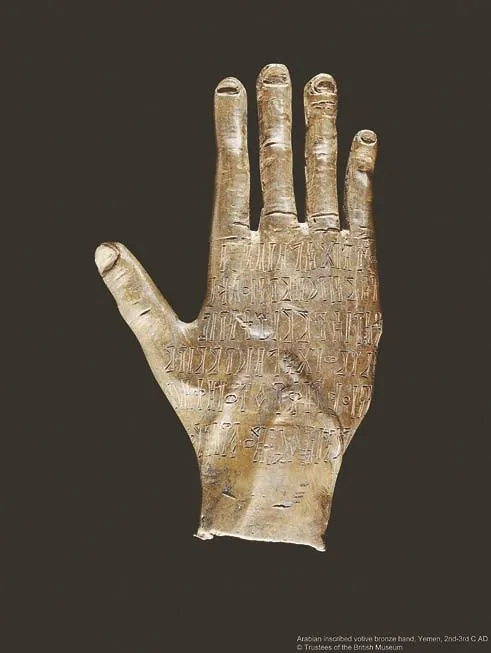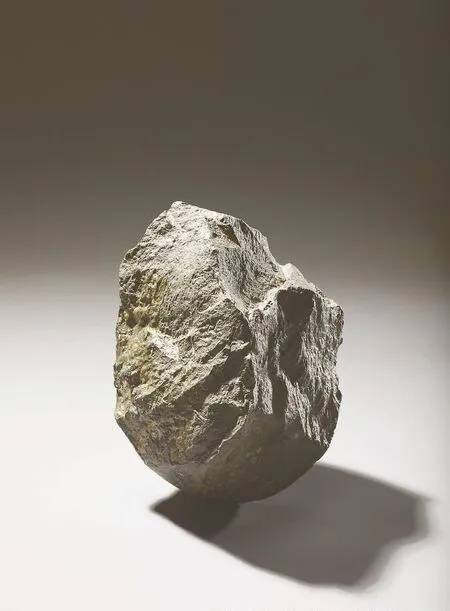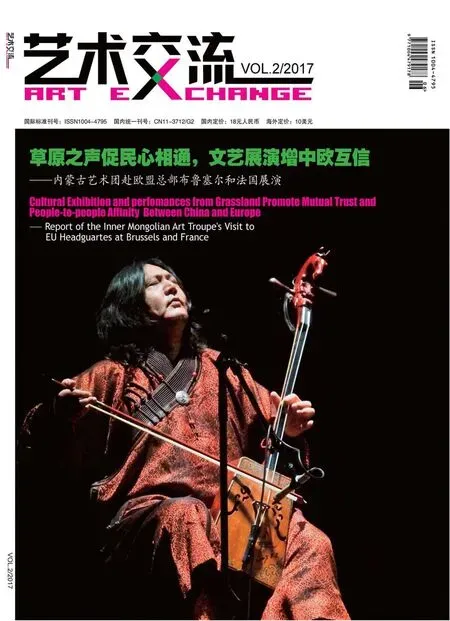听大英博物馆100件文物讲述200万年历史
文本刊记者 陈思静 Chen Sijing 译曹宇光Cao Yuguang
听大英博物馆100件文物讲述200万年历史
Narration of Two Million Years’ History by 100 Objects from British Museum
文本刊记者 陈思静 Chen Sijing 译曹宇光Cao Yuguang

王后竖琴 Queen’s Harp
从旧时器时代奥杜威峡谷出土的石质砍砸器,到21世纪中国生产的太阳能灯具等当代人工制品,3月2日至5月31日,在中国国家博物馆举办的“大英博物馆100件文物中的世界史”展览(以下简称“大英展”)向观众讲述了200万年人类文明的历程。
展览从大英博物馆800多万件藏品中精选出100件(组)展品,纵横200万年,横跨五大洲,从“开端”“最初的城市”“权力与哲学”“仪式与信仰”“贸易与侵略”“变革与适应”“邂逅与连结”“我们创造的世界”八个方面,向观众生动展现了世界文明的发展历程,“以崭新的立意使观众领略文物所揭示的不同文明间的密切联系,体会不同文明之间的对话和相互尊重的重要,感知不同文明之间的融合与影响”,中国国家博物馆副馆长黄振春说。
如何从大英博物馆百科全书式的藏品中精选出100件文物,大英博物馆馆长哈特维希•费舍尔解释说:“尽管展品中不乏表现人类技术及审美潜质的精美作品,但更加突出那些貌不惊人却内涵丰富的物品。一件微小的石质印章使得一个消失的文明重见天日,非洲海岸上被随意丢弃的陶瓷大片可以展现早期商人横穿印度洋的惊人航程。所有的文物聚集在一起,共同讲述了一部涵盖各大洲、纵横百万年的全球故事。”
与观众熟知的世界史叙事模式不同,展览并非旨在展现不同文明之间的差异,或者文明自身的独特性,而是通过两条线索突出其共性以及文明之间相互交融、彼此影响的事实。展览序言部分仅有的一件展品——古埃及女贵族佘盆梅海特的木棺——正向观众昭示了这种融合和影响。这个制作于公元前600年的木棺初看起来和人们常见的古埃及木棺并无二致,但是经过分析研究,人们发现,它的全部材料都来自埃及以外的地区:木料来自于黎巴嫩,黄金来自努比亚,青金石来自阿富汗,沥青来自两河流域。“这个普通的木棺试图向观众揭示,在早期文明时代,世界范围内的交流合作已经成为普遍现象。”展览英方策展人贝琳达•克里勒解释说,其一,资源、技术、思想、文化的传播与共享,造就人类文明本身,自古以来这种交流与融合就从未中断,并不断塑造着文明的轨迹;其二,尽管不同文明拥有风格各异的面貌,但其共同关心、尝试解决的问题却是一致的,因此文明的差异并不是产生分歧的理由,而是可供互相借鉴的契机。
良渚文化玉琮、西周康侯簋、商周时期的镈、东汉青瓷六博俑、唐代刘庭训墓的三彩文官俑、元代的青花瓷盘和龙首双耳瓶、2010年深圳出产的太阳能灯具与充电器等八件中国藏品在此次展出。同时,作为全球巡展,展览每到一地都会邀请当地博物馆精选一件自己馆藏的文物作为第101组展品,并与大英博物馆的100件藏品共同参展,中国国家博物馆的一组藏品“宣布中国重返世贸组织的木槌与签字笔”作为第101组展品参展。“世贸组织是一个致力于经济全球化的国际组织,中国作为世贸组织前身的创始国,历经15年的艰苦谈判,终于在2001年重返世界贸易组织,这对中国的改革开放来说,对于世界经济一体化来说都有重大意义。”展览中方策展人闫志解释。

霍克森胡椒瓶Hoxne Tiny Pepper Pot

阿拉伯铭文青铜手Wahab Ta’lab’s Bronze Hand
Ranging from the Stone Chopping Tool of Paleolithic Age found in Olduvai George to the contemporary artificial manufactures such as solar lamps made in China in the 21stcentury, the exhibition titled “A History of the World in 100 Objects” was held at National Museum of China(NMC) from March 2 till May 31 in narration of the two million years’ progress of human civilization.
This exhibition consisted of 100 selected items (sets) of exhibition out of over eight million pieces in the British Museum’s collection across the two million years in time and five continents in space. In eight parts, namely “Beginnings”, “The First Cities”, “Power and Philosophy”, “Ritual and Belief”, “Trading and Invading”, “Innovation and Adaptation”, “Encounters and Connections” and “The World of Our Making”, this exhibition provided a vivid showcase of the development course of the world civilizations.“With novel concept in curatorship, this exhibition will enable audiences to realize the close relationship between various civilizations as seen in objects, to sense the importance of dialogue and mutual respect between civilizations, and feel the integration and mutual influence between them as well.” Huang Zhenchun, vice president of NMC said.
As to the choice criterion of 100 objects in such an encyclopedia collection of the British Museum,Hartwig Fischer, president of the British Museum, explained, “Though some exquisite exhibits that reflect human technology and aesthetic potential do exist, we prefer to highlight those objects of simple countenance and abundant contents, as a tiny stone seal can bring an extinct civilization back to life and those porcelain fragments abandoned randomly along the African coast can demonstrate the amazing journey by early merchants across the Indian Ocean. All those objects are pieced together to jointly narrate a global story of all the continents in millions of years’ time”.
Different from the familiar narration mode of the world history, this exhibition, rather than showcasing the differences between civilizations or the unique features of a certain civilization, highlighted the common features through two threads of clues as well as the integration and mutual influence between civilizations. The only exhibit in the preface of this exhibition, inner coffin of Shepenmehyt, a woman aristocrat of Ancient Egypt, just indicated such integration and influence. Discoveries indicate that all its materials came from regions outside Egypt: the wood from Lebanon, the gold from Kush, lapis lazuli from Afghanistan and bitumen from Mesopotamia. “This ordinary wooden coffin tries to tell to the audiences that in the Early Civilization age the worldwide exchange and cooperation was already common.” Belinda Crerar, the British curator explained. First of all, the communications and sharing of sources, technology, thinking and cultures have created the human civilization, and this unceasing exchange and integration have constantly built up the track of civilizations. Secondly, different civilizations, despite their varied outlooks, share the identical concern for solving similar problems.Therefore the differences between civilizations provide an opportunity for reciprocal reference rather than reasons for conflict.
In this exhibition, eight Chinese objects such as jade Cong in Liangzhu Culture, bronze ritual vessel Gui in Western Zhou Dynasty, bronze bell between 600-400 B.C., lead-glazed earthenware Model of Liubo Players, Tang tomb figure in Tang Dynasty, blue-and-white porcelain plate and amphora in Yuan Dynasty, and solar lighting and charger made in Shenzhen in 2010 were on display. In the meanwhile, as a general practice of this global tour, a selected piece of objects from the local museum can be exhibited as No.101, together with those 100 objects from the British Museum. From NMC, the set of “Wooden Hammer and Pen used at China’s Re-accession into WTO” became the No.101. “WTO is an international organization committed to economic globalization. As the founding country of GATT, the former WTO,China eventually returned to WTO in 2011 after 15 years of painstaking negotiations , which bears a crucial significance for China’s reform and opening up as well as the global economic integration.” Yan Zhi,Chinese curator of this exhibition explained.

奥杜威砍砸器 Olduvai Stone Chopping Tool
——中国国家博物馆(中)

